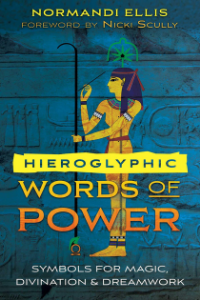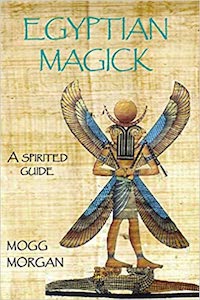
Hieroglyphic Words of Power: Symbols for Magic, Divination, and Dreamwork, by Normandi Ellis
Bear & Company, 1591433762, 336 pp., 2020
Egypt calls to mind all sorts of mysterious magic. Not only did the Egyptian empire last for over 3,000 years, the esoteric rites and occult magic have continued to be a cornerstone of Western magic to this day. Hieroglyphic Words of Power: Symbols for Magic, Divination, and Dreamwork by Normandi Ellis takes the reader into the mindset of those esteemed priests and priestesses of Egypt by teaching how to read the ancient hieroglyphs for magical and divinatory purposes.
I was drawn to this book because I have been very into exploring asteroids in my astrology chart, specifically Egyptian deities after finding out the asteroid Isis (42) is exactly conjunct Venus in my natal chart at 22 degrees Capricorn. For anyone with a bit of astrological knowledge, this degree of Capricorn has been a focus point of some major conjunctions this year! Since this transit began, I’ve been called to explore the mysteries of Egypt more deeply as I endeavor to decipher the archetype of Isis in my natal chart. Hieroglyphic Words of Power was a very useful book in strengthening my connection to the enchanting energy of Egypt.
What I like most about this book is the way Ellis describes the hieroglyphics as a sort of depth psychological poetry. She writes, “The consciousness of the creative intelligence that envisioned hieroglyphic communication operates in thought waves that defy logic.” 1 When viewed from this perspective, the hieroglyphs become living symbols that can be accessed intuitively in the liminal spaces of divination and dreams, allowing their meaning to be imbued in the context of their original conception, cutting through the separation of time and space.

Ellis divided the book into four sections: Introduction to the Hieroglyphs, The Unique Magic of their Hieroglyphs, The Hieroglyphs, and The Layouts. After delving into the history of hieroglyphs and explaining her own method of practice, study, and research, Ellis moves into how to use the magic of the hieroglyphs for the purpose of ritual magic, divination, and performing dream work.
I particularly enjoyed her writing on numerology with Egyptian meaning of the resonant energy for each digit. For those who may not be familiar with numerology, Ellis includes directions on how to calculate one’s birth path, personal year, and decipher the numerology of words using number-letter correspondences. One question I had while reading was if Ellis used the Pythagorean system of numerology or the Chaldean system because she highlights the influence of Egyptian practices on both Pythagoras and the Qabalah. I figured out by looking at her examples that she uses Pythagorean numerology. If you’re interested in learning more about the difference between these two systems, I have written about it here.
Back on topic now though, with the variety of ways offered to connect with the hieroglyphs, I decided to begin with dreamwork. Amazingly, the night I read that section and decided to try it out, I had my first ever dream of being in Egypt. Immersed in the dunes of sand, I gained the ability to soar into the clouds and overlook the whole region. I can tell you honestly that I never have had a dream like this before, and I fully attribute it to my working the practices in the book to open up to studying hieroglyphs in dreamtime, assisted by specific deities who protect and teach in this realm.
Another useful idea Ellis offers for learning the 60 hieroglyphs in this book is to create your own divination deck using the symbols. I appreciate how this method blends creativity with the process of learning the hieroglyphs and can also be used practically for divination. The entire next two sections are designed to assist the reader with building their own relationship to the hieroglyphs by working with them in the deck, meditation, and dreams.

The third section, which comprises the majority of the book, details 60 hieroglyphs that Ellis felt were best for the beginner to learn. For every hieroglyph Ellis offers an explanation of meaning, information about the context of meaning in Egyptian belief systems, and definitions that can be applied for understanding and divination using one’s numerology. Each hieroglyph also has a picture of it from Egypt and a drawing of it done by a graphic designer.
I’ve had a lot of success tracing the symbols in my journal and candles to connect with the hieroglyph. I decided to take the approach Ellis suggests of spending 2-3 days on a hieroglyph to get to know it’s meaning, energy, and wisdom. I am enjoying this slow and steady approach because it gives me the space to open to the hieroglyphs in an intuitive, experimental way. Each hieroglyph seems willing to speak when I am receptive to listening. Plus, I am nurturing my relationship with certain deities to assist with this process. No need to rush this practice. 🙂
Finally, the last section offers readings that can be done using the hieroglyphic images for divination. There is information on calculating one’s numerology, a variety of spreads that can be used, and most helpful, sample oracle readings that give the reader an idea of how to integrate the hieroglyphs to discern a clear message. I haven’t finished creating my oracle deck yet so I haven’t practiced the readings, but I am looking forward to trying them out when the time is right. They all look very useful and soulfully designed to help the reader gain insight into their questions and concerns.
Overall, I believe Hieroglyphic Words of Power is a wonderful guide to establishing the use of hieroglyphs in one’s personal practice. There’s something about Egypt magic that is so intriguing, yet elusive when we have no guide. Ellis has put together a method of study that is comprehensive, accessible, and transformative when undertaken. I recommend this book to anyone who is looking to begin strengthening their connection to the magic of Egypt, whether to develop relationships with deities or learn another method of divination based on the combination of dreamwork, numerology, and hieroglyphs. There’s a lot interwoven in this book and I’m sure it will remain one I refer back to often over time.
Alanna Kali is an astrologer, numerologist, and pioneer spirit that loves to explore life through the lens of depth psychology. She has a passion for studying the humanities and social trends. Her academic work is centered upon reuniting body, mind, and spirit through eco-psychology. She loves reading, spending time in nature, and travel.


